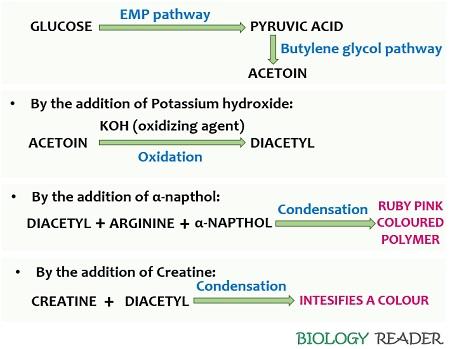Voges Proskauer test depends upon the formation of a neutral end product “Acetoin” in the MRVP media, which directly relies on the breakdown of glucose into an intermediate product, pyruvic acid. The pyruvic acid enters the butylene glycol pathway and produces an end product named acetyl methyl carbinol or acetoin.
It is named after the contribution of the two bacteriologists named Voges and Proskauer, who first observed the formation of red-pink colour in the media after the incorporation of potassium hydroxide.
Later, Harden studied the reason for the colour change and concluded that the colour changed due to acetoin formation. In 1936, Baritt used two reagents (KOH and α-naphthol) to perform the VP test.
Both α-naphthol and KOH are now being very popular and named as Baritt’s-I and Baritt’s-II reagent. Further, two more scientists (Barry and Feeney) pioneered a rapid method of VP test by using creatine reagent.
Content: Voges Proskauer Test
Definition
Voges Proskauer test ascertains the organism’s potential to form a neutral end product “Acetyl methyl carbinol” by supplying enough glucose. It makes the use of standard media (MRVP broth) and two reagents (KOH and α-naphthol). It is also abbreviated as the VP test.
A VP positive organisms generally exploit glucose and degrade it into a metabolic product (pyruvic acid) by following the EMP pathway. Then, the test organisms further split the pyruvic acid into AMC or acetoin once it enters the butylene glycol pathway.
Principle of Voges Proskauer Test
Voges Proskauer test includes a series of reaction, where primary substrate glucose metabolizes into intermediate product pyruvate. Pyruvate enters the butylene glycol pathway to form neutral by-product acetoin. Then, oxidation of acetoin occurs by the treatment with ‘KOH’ (an oxidizing agent).

Potassium hydroxide will react with acetoin to form a compound named Diacetyl. On further treatment, diacetyl condenses with the α-naphthol and the guanidine containing compounds to give a ruby pink colour to the media. Creatine contains a free –NH2 group that condenses with diacetyl to intensify the colour of a product formed.
Media and Reagents
Voges Proskauer test uses MRVP broth as a standard media and two reagents, namely VP-I and VP-II:
Composition of MRVP broth:
- Polypeptone: 7 g
- Glucose: 5 g
- Dipotassium phosphate: 5 g
- Distilled water: 1 L
- Final pH: 6.9
The composition of VP-I reagent or “Barrit’s reagent-I” includes α-naphthol as a colour intensifier. To prepare 5% of α-naphthol, we require:
- α-naphthol: 5 grams
- Absolute ethanol: 100 ml
The composition of VP-II reagent or “Barrit’s reagent-II” includes potassium hydroxide as an oxidizing reagent. To prepare 40% of KOH solution, we require:
- KOH: 40 grams
- Distilled water: 100 ml
Nowadays, creatine reagent serves as a colour intensifier and to prepare 0.5% of creatine, we require:
- Creatine: 0.5 grams
- Distilled water: 100 ml
Procedure
The procedure of the VP test includes the following steps:
- Prepare MRVP broth and the reagents for the experiment.
- Autoclave the MRVP broth, and pour this liquid media into the sterilized test tubes.
- Take little inoculum and inoculate it into the broth via a sterilized inoculating loop.
- Then, incubate the test tubes for a minimum of 2 days.
- After incubation, add 0.6 ml of VP-I reagent and then 0.2 ml VP-II reagent.
- Allow the test tubes to stand for at least 10 minutes and observe the test tubes for any colour change.
Result Interpretation
Positive: A ruby pink colour appears on the top of the broth.
Examples: Serratia marcescens, Vibrio eltor, Listeria sp, Enterobacter sp etc.

Negative: No colour change in the broth indicates a negative VP test.
Examples: Streptococcus mitis, Salmonella sp, Citrobacter sp, Yersinia sp, Shigella sp etc.
Limitations
Voges Proskauer test includes the following limitations:
- The VP-I and VP-II reagent should be added sequentially and in a proper ratio.
- The test tubes must be shaken before concluding the results.
- Some test organism degrades “Acetoin” and interprets erroneous results.
- Sometimes, α-naphthol and KOH reagent react to give off a copper-like colour and gives a negative result.
Therefore, the Voges Proskauer test differentiates the two major types of anaerobic enteric bacteria based on the production of a neutral product, and it is performed alongside the methyl red test.